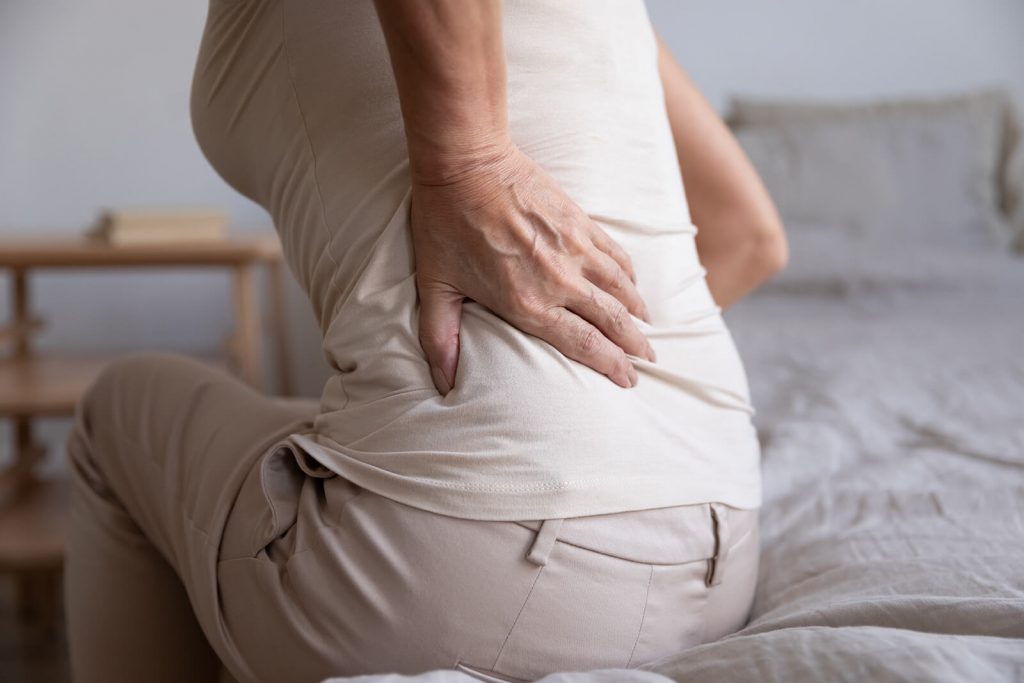We all suffer the occasional bout of back pain or stiffness. However, chronic pain in the lower back and hips may signal something more serious. Poor posture, overdoing it at the gym or even a bad night’s sleep can all contribute to aches and pain in the back, neck and shoulders.
However, if you experience ongoing pain for no apparent reason, or if the aches are worse after rest and better with activity, it may be time to seek medical help to rule out something more serious. One of the conditions that may go under the radar is ankylosing spondylitis, an autoimmune disease that affects the tissues and bones in the spine.

Causes & Symptoms
Ankylosing spondylitis is an autoimmune disease. There is some evidence that a gene called HLA-B27 plays a role in increasing the risk of developing ankylosing spondylitis. However, not everyone with the gene develops the condition. Apart from genes, other risk factors include gender and age. More men than women develop ankylosing spondylitis, and the condition tends to occur in late adolescence and early adulthood. Some key characteristics to look out for include pain and stiffness in the:
- Lower back
- Pain in the buttocks arising from the sacroiliac joint between the base of your spine and your pelvis
- Cartilage between your breastbone and ribs
- Heel pain
- Red and painful eyes
The pain may awaken you from sleep. Usually, the pain improves with exercise and worsens if you have been inactive for a time. In some cases, the aches and pains are accompanied by eye problems such as painful red eyes.
See a doctor if you experience these symptoms so that you can benefit from early treatment and avoid irreversible damage to the joints or other complications. This is important as, left untreated, ankylosing spondylitis can cause some of the vertebrae in your spine to fuse. This is because the body – in response to the inflammation caused by the condition – builds new bone in an attempt to heal. The new bone then bridges the gap between the vertebrae, causing the spine to become stiff and inflexible (bamboo spine), leading to a hunched posture.
The condition can also affect the ribs, which can impair the ability to breathe deeply.
Diagnosis & Treatment
To diagnose ankylosing spondylitis, your doctor will do some physical tests to gauge the range of movement in your spine, hips, legs and chest. Other tests may include blood tests, X-rays and magnetic resonance imaging (MRI).
While there is no cure for the condition, it can be controlled with medication that reduces the symptoms but also controls the immune system. Physical therapy helps to maintain mobility and strengthen surrounding muscles. In most cases, surgery is not recommended unless certain joints, such as the hips or knees, are so damaged that they need to be replaced. The goal of treatment is to control the immune system, reduce inflammation and pain, and to delay the onset of complications and permanent damage to the joints. Commonly, non-steroidal anti-inflammatory drugs (NSAIDs) are prescribed for inflammation and pain relief. Other drugs may also be given to ‘block’ the proteins that drive the abnormal immune system reaction. It is important to comply with your treatment regimen and have close follow-up with your rheumatologist to minimise side effects and have the maximum benefit from the medications.
Some non-medical approaches to managing ankylosing spondylitis include physical therapy, which is aimed at improving strength and flexibility. You may also be advised to make lifestyle changes, such as doing more range-of-motion and stretching exercises, and maintaining good posture in the way you sit, walk and even sleep.







